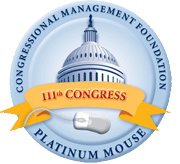(Washington, DC) – Today, the House Committee on Science and Technology’s Energy and Environment Subcommittee held a hearing to discuss forecasting data and services necessary to expand reliable, renewable sources of power. The hearing also explored the research, development, demonstration, and monitoring needs in this area that are not currently being adequately addressed.
Renewable energy is energy derived from natural resources such as sunlight, wind, and tides, which are replenished by nature. According to the Department of Energy (DOE), nearly a quarter of electric power in the U.S. was generated from renewable sources in 2009. A significant barrier to a more widespread adoption of many forms of renewable energy is that these sources are intermittent. Because the energy sources are not steadily available at all times, electric grid managers adjust the delivery of other sources of power based on expected changes in renewable power output. To forecast these expected changes, scientists must take into account several factors such as the changing weather conditions and the land’s topography.
“The disaster in the Gulf of Mexico is more than enough evidence that it is critical that we expand our use of renewable energy sources. We have to look to solar, wind, and water power for the future. With that in mind, it is vital we improve our ability to forecast for renewable energy. It can create billions of dollars in operational and cost savings,” said Chairman Brian Baird (D- WA).
Current observational networks in the United States are relatively sparse and widely spaced, and are therefore not well-suited to forecast wind energy generation. Members and witnesses discussed a need to integrate wind forecasting tools into energy management system applications. The monitoring and modeling requirements to achieve an accurate solar power forecast, which is heavily dependent on satellite data, was also discussed.
“Recent studies led by the National Renewable Energy Laboratory have shown that improving the accuracy and frequency of these forecasts can have a major impact on the economic viability of renewable energy resources,” said Vice Chairman Paul Tonko (D-NY).
One focus of the hearing was an examination of the role that the National Oceanic and Atmospheric Administration (NOAA) plays in supporting renewable energy, and how its capabilities could be further developed to better serve the needs of renewable energy developers and consumers. To address these issues, NOAA leverages research capacities across the agency, as well as partnerships with other federal agencies and such as DOE and the National Aeronautics and Space Administration (NASA), national laboratories, cooperative institutes, universities, and international research organizations.
In addition to witnesses representing various federal agencies, testimony was presented from the private sector to highlight the role that private renewable forecasters play relative to and in collaboration with services offered by the public sector. This testimony also recommended that the public and private forecasting sectors develop a joint roadmap to identify ways to best leverage the capabilities of each and avoid unnecessary duplication of effort.
To gain further information on these issues, the Federal Energy Regulatory Commission (FERC) issued a Notice of Inquiry (NOI) in January of this year on “the extent to which barriers may exist that impede the reliable and efficient integration of variable energy resources into the electric grid, and whether reforms are needed to eliminate those barriers.” The Notice posed questions about current practices used to forecast power production from variable energy resources, and whether those practices would be adequate as the number of these resources increases. Ms. Jamie Simler, director of the Office of Energy Policy and Innovation at FERC, testified on the NOI and the responses the Commission has received to date.
For more information, please see the Committee’s website.
###
111.212
